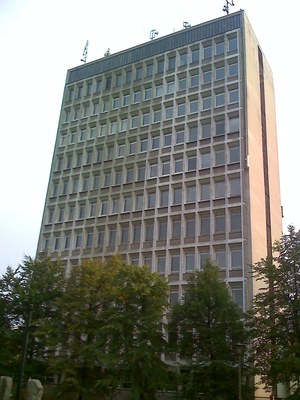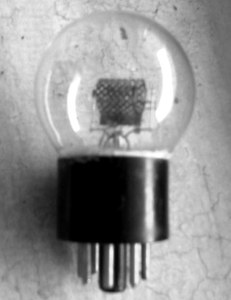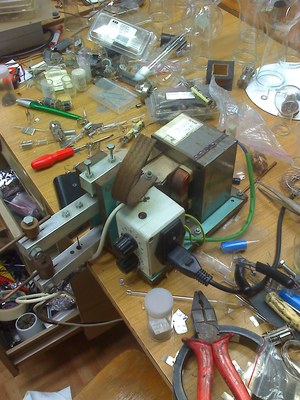Over the past several years DIY projects, open source hardware and hacker spaces have been growing in scope and popularity, as we have discussed in an earlier article.
Despite open hardware's growing popularity, many hardware specs and technologies remain proprietary. Vacuum technology, which is at the core of the manufacturing of many devices such as microprocessors, touchscreens and miniature (MEMS) accelerometers, remain mostly untouched by hardware hackers. However, there is a growing trend among engineers and the generally ambitious to buck preconceived notions of what is possible in the realm of hardware hacking. Among these innovative engineers is Aleksander Zawada, whom we will focus on in the rest of this article.
Aleksander Zawada and Prywatna Wytwórnia Lamp
I've recently had the pleasure of meeting Aleksander at his home laboratory in Warsaw, Poland. Aleksander is the creator of vacuum-tube laboratory Prywatna Wytwórnia Lamp (PWL), which in English, translates to "Private Tube Manufacturer" - a pun on PWLR ("National Tube Manufacturer"), the first Polish tube manufacturer after WWII. Before the laboratory started to expand into the Institute of Vacuum Technology, Aleksander started everything in his own private apartment.
I asked Aleksander why he is motivated to run this small laboratory, and he said that part of it is to resurrect a historically relevant industry, and part of it is genuine interest and curiosity.
PWL is unlike any hacker/maker space I've ever visited, solely based on the ingenuity of the equipment and the intricacy of each project. Ever the gracious host, Aleks offered to show the step-by-step creation of a triode. But mind you - he does not stop at triodes. The lab is full of contraptions that he built: canal ray tubes, a RGB magic eye, several Crookes tubes, multiple (still untested) attempts at making Geiger tubes, and many other incredibly amazing devices.
Khrushchev and Dumpster Diving
To keep his hobby affordable, Aleksander Zawada uses a remarkable amount of creativity and resourcefulness. Vacuum pump equipment, vacuum furnaces, torches, ultrasonic cleaners and an assortment of chemicals are just some of the basic equipment Aleksander uses in his laboratory. Most of these devices and materials can easily cost upwards of thousands of dollars. Undeterred by this, Aleksander solves the cost issue in the most DIY-way possible: he dumpster-dives. Aleks wryly describes the process, saying that,
In the [garbage of] institutes, or in the schools, there is a lot of kilometers of tungsten wire, tantalum plates and pumps and another devices, and if you know when and where, you can have everything, but... it's almost as... hum.... [as discreet as] Nikita Khrushchev's funeral: [advanced and expensive equipment that everyone in the lab used to talk about at some point is sometimes slowly forgotten and then quietly thrown away. It happens] quickly, silently... you must know when and where, and get there before the trash man does.
Most of his equipment is salvaged from scientific institute dumpsters, or created out of ordinary consumer goods. Some of his hybrid dumpster/consumer good creations include a microwave oven transformer-based spot welding machine, and an old record player turntable that he hacked to spin glass while melting it.
Do it Yourself
Aleksander's lab is one example of innovative DIY spaces. There is a growing number of hackerspaces and collaborative hardware projects to get involved in. If you want more information about PWL and detailed instructions on creating triodes, you can find this information on Aleksander's website, or you can watch his EHSM lecture on our YouTube channel.
For more projects that push the frontiers of DIY, join us at the Exceptionally Hard and Soft Meeting (EHSM). The EHSM taking place this year at DESY in Hamburg will explore DIY and open source projects that are going beyond previously conceptualized limits and introducing the people behind those innovations. Everyone is invited to submit relevant lectures or tutorials to the conference, and all curious persons can attend. All information is on our website http://ehsm.eu.


